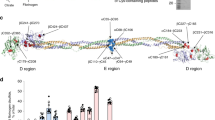Abstract
Fibrinogen (FB) is a soluble blood plasma protein and is a key molecule involved in coagulation. Oxidative modification of proteins, such as the formation of advanced oxidation protein products (AOPP), a heterogeneous family of protein compounds structurally modified and derived from oxidative stress, may be associated with the pathophysiology of a number of chronic inflammatory diseases. Therefore, the aim of this study was to determine whether the formation of this mediator of inflammation occurs from FB and whether its generation is associated with structural changes. Results of the present study suggest that the oxidation of FB may provoke the formation of AOPP, which in turn, may promote functional alterations in FB, thus causing changes in its structural domains and increasing its procoagulant activity.





Similar content being viewed by others
References
Liu, C.Y., H.L. Nossel, and K.L. Kaplan. 1979. The binding of thrombin by fibrin. The Journal of Biological Chemistry 254: 10421–10425.
Collen, D., G. Tygat, H. Claeys, and R. Piessens. 1972. Metabolism and distribution of fibrinogen. I. Fibrinogen turnover in physiological conditions in humans. British Journal of Haematology 22: 681–700.
Brow, J.H., N. Volkmann, G. Jun, A.H. Henschen-Edman, and C. Cohen. 2000. The crystal structure of modified bovine fibrinogen. Proceedings of National Academy of Sciences of the United States of America 97: 85–90.
Hall, C.E., and H.S. Slayter. 1959. The fibrinogen molecule: its size, shape, and mode of polymerization. The Journal of the Biophysical and Biochemical Cytology 5: 11–16.
Kollman, J.M., L. Pandi, M.R. Sawaya, M. Riley, and R.F. Doolittle. 2009. Crystal structure of human fibrinogen. Biochemistry 48: 3877–3886.
Budzynski, A.Z., S.A. Olexa, and B.V. Pandya. 1983. Fibrin polymerization sites in fibrinogen and fibrin fragments. Annals of the New York Academy of Sciences 408: 301–314.
Martinez, M., J.W. Weisel, and H. Ischiropoulos. Functional impact of oxidative posttranslational modifications on fibrinogen and fibrin clots. 2013. Free Radical Biology and Medicine 65: 411-418.
Dalle-Donne, I., R. Rossi, D. Giustarini, A. Milzani, and R. Colombo. 2003. Protein carbonyl groups as biomarkers of oxidative stress. Clinica Chimica Acta 329: 23–38.
Witko-Sarsat, V., M. Friedlander, C. Capeillère-Blandin, A.T. Nguyen-Khoa, A.T. Nguyen, J. Zingraff, P. Jungers, et al. 1996. Advanced oxidation protein products as a novel marker of oxidative stress in uremia. Kidney International 49: 1304–1313.
Capeillere-Blandin, C., V. Gausson, B. Descamps-Latscha, and V. Witko-Sarsat. 2004. Biochemical and spectrophotometric significance of advanced oxidized protein products. Biochimica et Biophysica Acta 1689: 91–102.
Selmeci, L., M. Székely, P. Soós, L. Seres, N. Klinga, and A. Geiger. 2006. Human blood plasma advanced oxidation protein products (AOPP) correlates with fibrinogen levels. Free Radical Research 40: 952–958.
Bochi, G.V., V.D. Torbitz, L.P. Cargnin, M.B. Sangoi, R.C. Santos, P. Gomes, et al. 2012. Fructose-1,6-bisphosphate and N-acetylcysteine attenuate the formation of advanced oxidation protein products, a new class of inflammatory mediators, in vitro. Inflammation 35: 1786–1792.
Hanasand, M., R. Omdal, K.B. Norheim, L.G. Gøransson, C. Brede, and G. Jonsson. 2013. Improved detection of advanced oxidation protein products in plasma. Clinica Chimica Acta 413: 901–906.
Carr, Jr., and J. Hermans. 1978. Size and density of fibrin fibers from turbidity. Macromolecules 11: 46–50.
Laemmli, U.K. 1970. Cleavage of structural proteins during the assembly of the head of bacteriophage T4. Nature 227: 680–685.
Witko-Sarsat, V., V. Gausson, A.T. Nguyen, M. Touam, T. Drüeke, F. Santangelo, et al. 2003. AOPP-induced activation of human neutrophil and monocyte oxidative metabolism: a potential target for N-acetylcysteine treatment in dialysis patients. Kidney International 64: 82–91.
Margret, C.M., and C.C. Winterbourn. 1991. Oxidative damage to fibrinonectin I. Effects of the Neutrophil myeloperoxidase system and HOCl. The Archieves of Biochemistry and Biophysics 15: 53–59.
Weigandt, K.M., N. White, D. Chung, E. Ellingson, Y. Wang, and X. Fu. 2012. Fibrin clot structure and mechanics associated with specific oxidation of methionine residues in fibrinogen. Biophysical Journal 103: 2399–2407.
Kannel, W.B., P.A. Wolf, W.P. Castelli, and R.B. D’Agostino. 1987. Fibrinogen and risk of cardiovascular disease. The Framingham Study. JAMA 258: 1183–1186.
Stec, J.J., H. Silbershatz, G.H. Tofler, T.H. Matheney, P. Sutherland, I. Lipinska, et al. 2000. Association of fibrinogen with cardiovascular risk factors and cardiovascular disease in the Framingham Offspring Population. Circulation 102: 1634–1638.
Upchurch Jr., G.R., N. Ramdev, M.T. Walsh, and J. Loscalzo. 1998. Prothrombotic consequences of the oxidation of fibrinogen and their inhibition by aspirin. Journal of Thrombosis and Thrombolysis 5: 9–14.
Belisario, M.A., C. Di Domenico, A. Pelagalli, R. Della Morte, and N. Staiano. 1997. Metal-ion catalyzed oxidation affects fibrinogen activity on platelet aggregation and adhesion. Biochimie 79: 449–455.
Acknowledgments
This study was supported by scholarships from Conselho Nacional de Desenvolvimento Científico e Tecnológico (CNPq, Brazil) and Coordenação de Aperfeiçoamento de Pessoal de Nível Superior (CAPES, Brazil).
Conflict of Interest
There are no conflicts of interest to declare.
Author information
Authors and Affiliations
Corresponding author
Rights and permissions
About this article
Cite this article
Torbitz, V.D., Bochi, G.V., de Carvalho, J.A.M. et al. In Vitro Oxidation of Fibrinogen Promotes Functional Alterations and Formation of Advanced Oxidation Protein Products, an Inflammation Mediator. Inflammation 38, 1201–1206 (2015). https://doi.org/10.1007/s10753-014-0085-x
Published:
Issue Date:
DOI: https://doi.org/10.1007/s10753-014-0085-x




